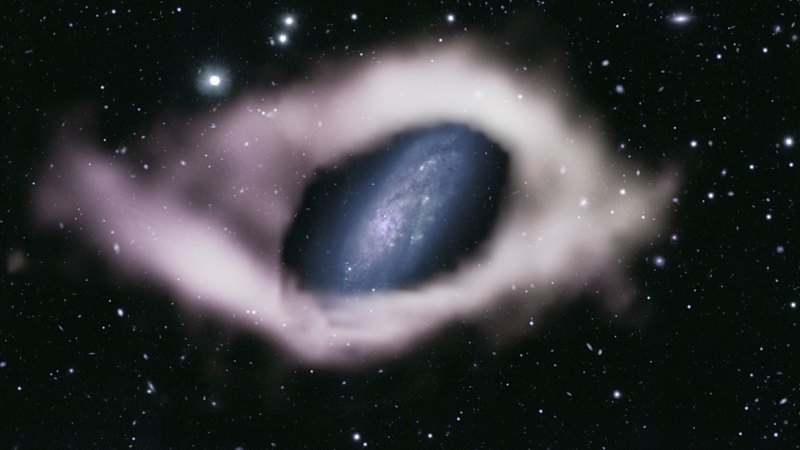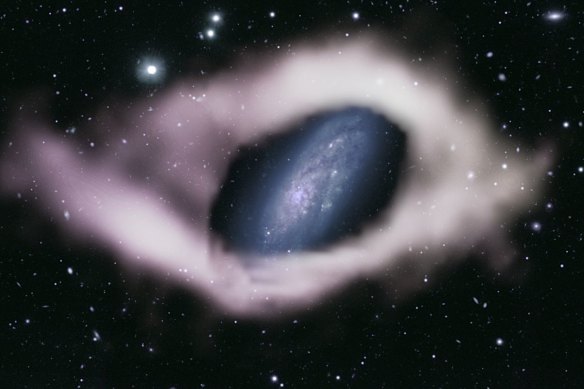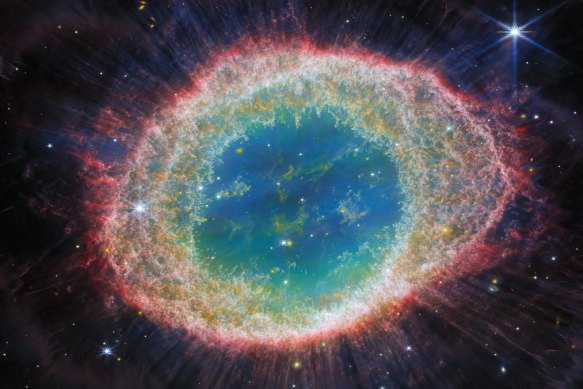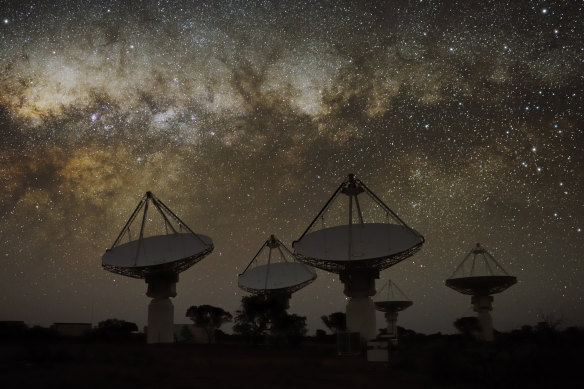Save articles for later
Add articles to your saved list and come back to them any time.
A rare, dazzling “cosmic ribbon” that adorns an entire galaxy has revealed itself with the help of an Australian telescope. The spectacular gaseous ring could unlock secrets of the elusive substance that underpins the structure of the universe – dark matter.
The formation appears to be a polar ring galaxy, a dramatic structure that has a glowing fringe of hydrogen wrapped around the galaxy’s main spiral.
The “cosmic ribbon” of a polar ring galaxy captured by the CSIRO’s ASKAP radio telescope.Credit: J. English, N. Deg, the WALLABY team, CSIRO/ASKAP radio telescope and NAOJ/Subaru Telescope
The CSIRO’s ASKAP radio telescope on Wajarri Yamaji Country in Western Australia detected the ring encircling a galaxy 56 million light years away.
Astronomers discovered the formation while analysing early data from the WALLABY survey, an ambitious effort to scan half of the southern hemisphere for gas structures in hundreds of thousands of galaxies.
“The findings suggest that 1-3 per cent of nearby galaxies may have gaseous polar rings, which is much higher than suggested by optical telescopes,” said Dr Nathan Deg, co-author of the research from Queen’s University Canada.
The structures can form when two galaxies smash together, and the smaller galaxy becomes a gas-rich swirl rotating around the larger galaxy.
But the galaxy captured by ASKAP probably stole its shining ring by siphoning gas from a smaller neighbouring galaxy with its gravitational pull, CSIRO professor and co-author of the research Bärbel Koribalski said.
“The bigger galaxy is kind of bullying the neighbour, it’s taking away the gas,” she said. “And depending on where they are in the sky and how they rotate, the gas might be created into a larger disc, or in this case, it formed a polar ring around the galaxy.”
Squinting at images generated from the data, Koribalski said she spotted sparks of new stars forming from the rich hydrogen, like diamonds willing themselves into existence along a silver ring.
NASA’s James Webb Space Telescope released an image of the ring nebula in historic detail last month.Credit: SA/Webb, NASA, CSA, M. Barlow (UCL), N. Cox (ACRI-ST), R. Wesson (Cardiff University)
But it’s not just a visual spectacle – these cosmic rings could reveal precious information about dark matter, the enigmatic substance that makes up a third of the universe.
“It’s kind of really embarrassing,” Koribalski said. “We still don’t know what dark matter is.
“The crucial bit here is why would such a ring be stable around the pole? Why aren’t they inclined? Something is stablising them to sit around the pole: that’s the halo of the galaxy. And most of the halo is made from dark matter.”
Further analysis of these rings could shed crucial light on dark matter’s structure, and the discoveries from the WALLABY survey have only just begun, Koribalski said.
The Australian Square Kilometre Array Pathfinder (ASKAP) radio telescope in Western Australia.Credit: Alex Cherney
“ASKAP is 36 telescopes spread over a six kilometre area, effectively forming a telescope six kilometres in diameter. You couldn’t build a single telescope like that – it’s very powerful and it has super-high resolution.
“Our field of view has grown a hundredfold – the data flood has started. Every day, someone says, ‘What is this, what is that, I’ve never seen this before!’ It’s an incredibly exciting time.”
The James Webb Space Telescope recently unveiled another cosmic structure in historic detail; the ring nebula.
The expanding shell of gas is an example of a planetary nebula and it occurs as a star thrusts out layers of glowing gas, at a speed of 20-30 kilometres per second, as it runs out of fuel towards the end of its life.
The new image offers a glimpse of the destiny of our own sun, which will begin to collapse after running out of nuclear fuel in about five billion years.
The Examine newsletter explains and analyses science with a rigorous focus on the evidence. Sign up to get it each week.
Most Viewed in National
From our partners
Source: Read Full Article



